Want to optimize your IT ecosystem?
Consult with our team!
Published: 26 March, 2025 · 7 mins read
Tired of your messy IT ecosystem? Discover how application rationalization turns IT into an efficient, business-centered machine.
Do you feel like your IT ecosystem is becoming more complex by the day? Legacy systems, SaaS solutions, and custom apps—some overlap, while others collect digital dust. Managing all this is costly
(40% of yearly IT operating expenses
go to business applications) and simply inefficient. If you’re already facing these issues, now is the time to consider app rationalization.
Application rationalization is a strategy that involves evaluating and eliminating duplicate or underutilized software within your organization. The process does its job — it helps you declutter, reduce costs, and become more efficient.
As a
support and modernization services
provider, we’ve helped lots of businesses streamline their IT ecosystems. For example, we made our client’s app leaner and faster by cleaning up their code. In this guide, we’ll explain why app rationalization matters and how to assess and optimize your software portfolio.
Highlights:
Consult with our team!
Why should you care about application portfolio rationalization in the first place? It’s simple. Keeping outdated, redundant, or unnecessary apps:
Not to mention, shadow IT, software your teams may adopt without official approval. It can increase your spending and introduce security risks that you can easily avoid. Mergers and acquisitions make things even messier, often leaving you with overlapping systems that do the same thing but don’t communicate.
“Companies are starting to realize that a bloated app portfolio is not just expensive, it’s unsustainable. With
70% of M&A-driven IT integrations
failing due to poor early-stage planning, businesses can’t afford to ignore the application rationalization framework.”
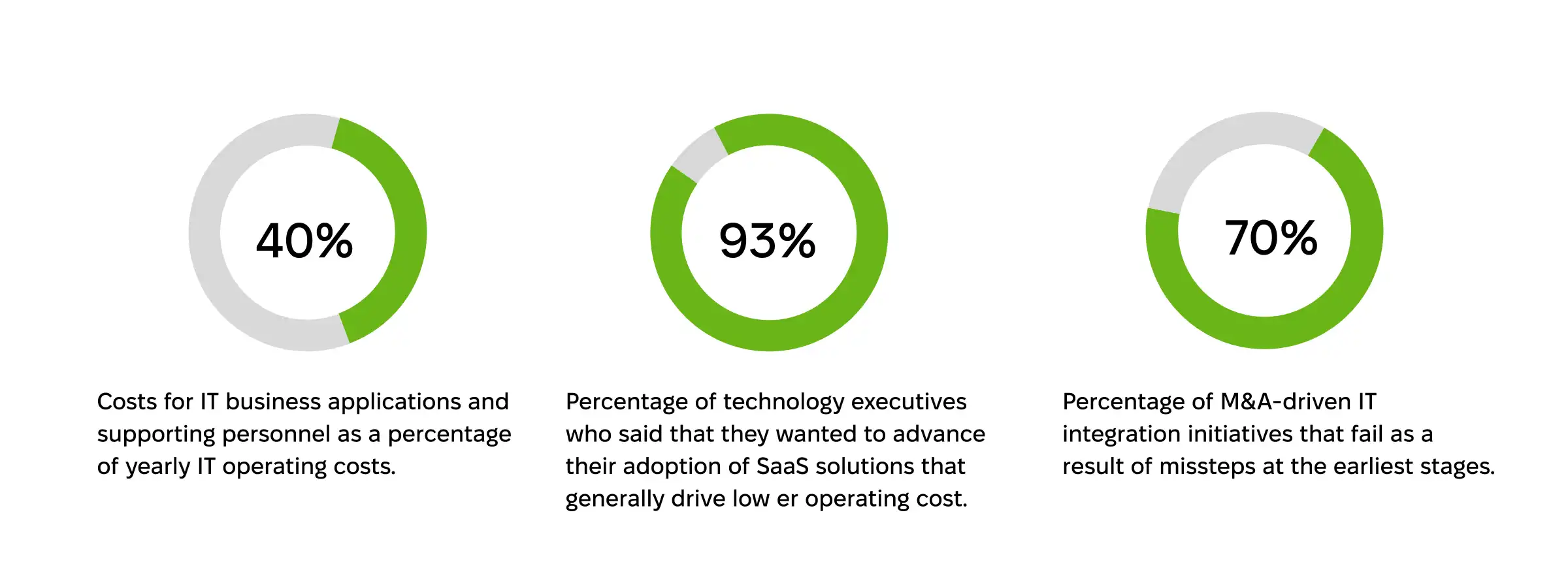
So, what are the application rationalization benefits? Beyond cost reduction, simplified compliance, and improved decision-making, it’s about ensuring your IT ecosystem is actually helping you reach your business goals.
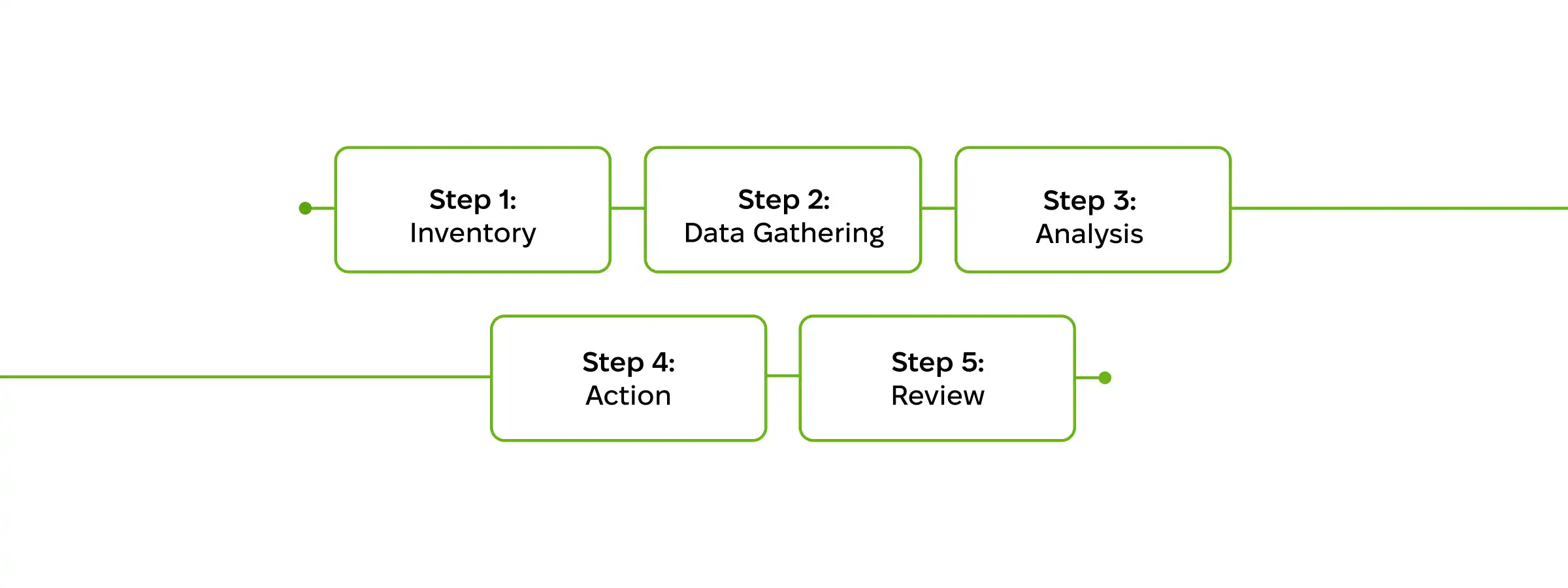
Before making any decisions, you need to take stock of everything — every app, every piece of software used across your organization.
Use automated discovery tools, spreadsheets, and good old-fashioned interviews to identify all the applications. During the process, you’ll likely uncover shadow IT — apps you didn’t even know existed. Make a list of every tool, whether officially approved or not.
Once you have a list, start gathering data. You need to know how often each app is used, who uses it, how much it costs, and its business value. Usage analytics reports, cost statements, and user surveys may help you with data collection.
At this point of the application portfolio rationalization process, you need to analyze your findings. Identify which apps are keepers, which are duplicates, and which are just plain obsolete. Categorize them as ROT — redundant, outdated, trivial. You may also use a scoring system to rate applications depending on their business value.
That’s where the application rationalization methodology brings tangible results. Execute your plan by retiring unnecessary apps, migrating to better alternatives, consolidating redundant software, and modernizing the architectures of the ones you keep.
If interested, you can learn more about the software components in our
web app architecture guide.
After you implement the IT rationalization plan, review your current ecosystem. In fact, conduct such reviews regularly. Monitor key metrics to make sure that new redundancies don’t appear and that your software investments are justified.
| Step | Time | Approach | Challenges |
|---|---|---|---|
| 1. Inventory | 1–2 weeks | Identify all applications used within your organization | Lack of visibility into all software in use, especially shadow IT |
| 2. Data gathering | 2–3 weeks | Collect usage data, costs, and business value of each app | Inconsistent or missing data from different teams |
| 3. Analysis | 2–4 weeks | Categorize apps as redundant, outdated, or trivial | Difficult decisions about retiring or consolidating apps |
| 4. Action | 4–12 weeks | Retire, replace, consolidate, or modernize apps based on findings | Stakeholder pushback and change management difficulties |
| 5. Review | Ongoing | Continuously monitor your IT ecosystem | Lack of governance leads to potential redundancies |
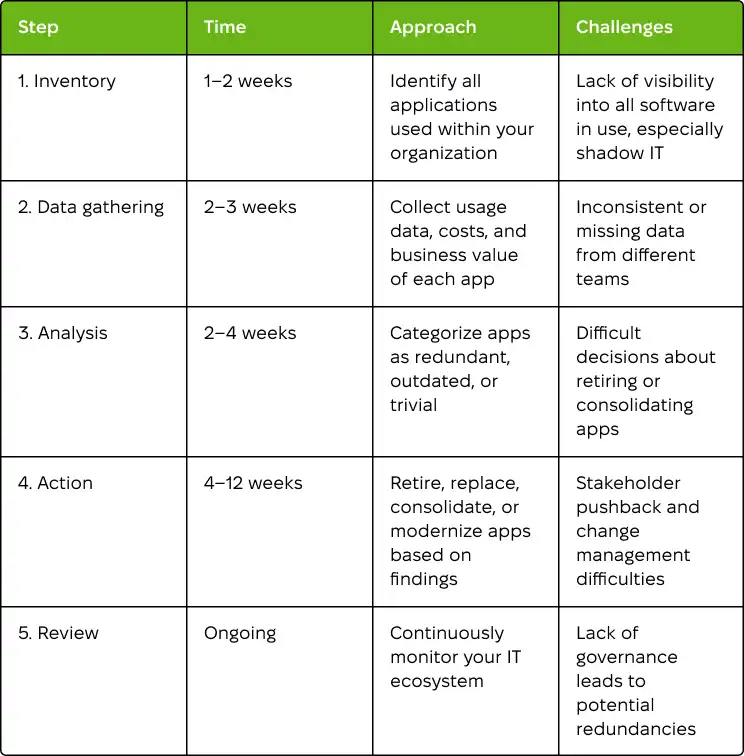
“Getting stakeholder buy-in is one of the biggest hurdles in the application rationalization process. Teams get attached to their tools, and convincing them to let go of inefficient apps requires clear communication and a well-thought-out strategy.”
Talk to our team!
You’ve got the steps and developed the plan, but how to make sure it actually works? Don’t worry, we prepared several tips for a successful applications rationalization strategy.
“What we constantly see is that by optimizing their IT ecosystem, businesses free up resources — both budget and manpower — that can then be reinvested into innovation.”
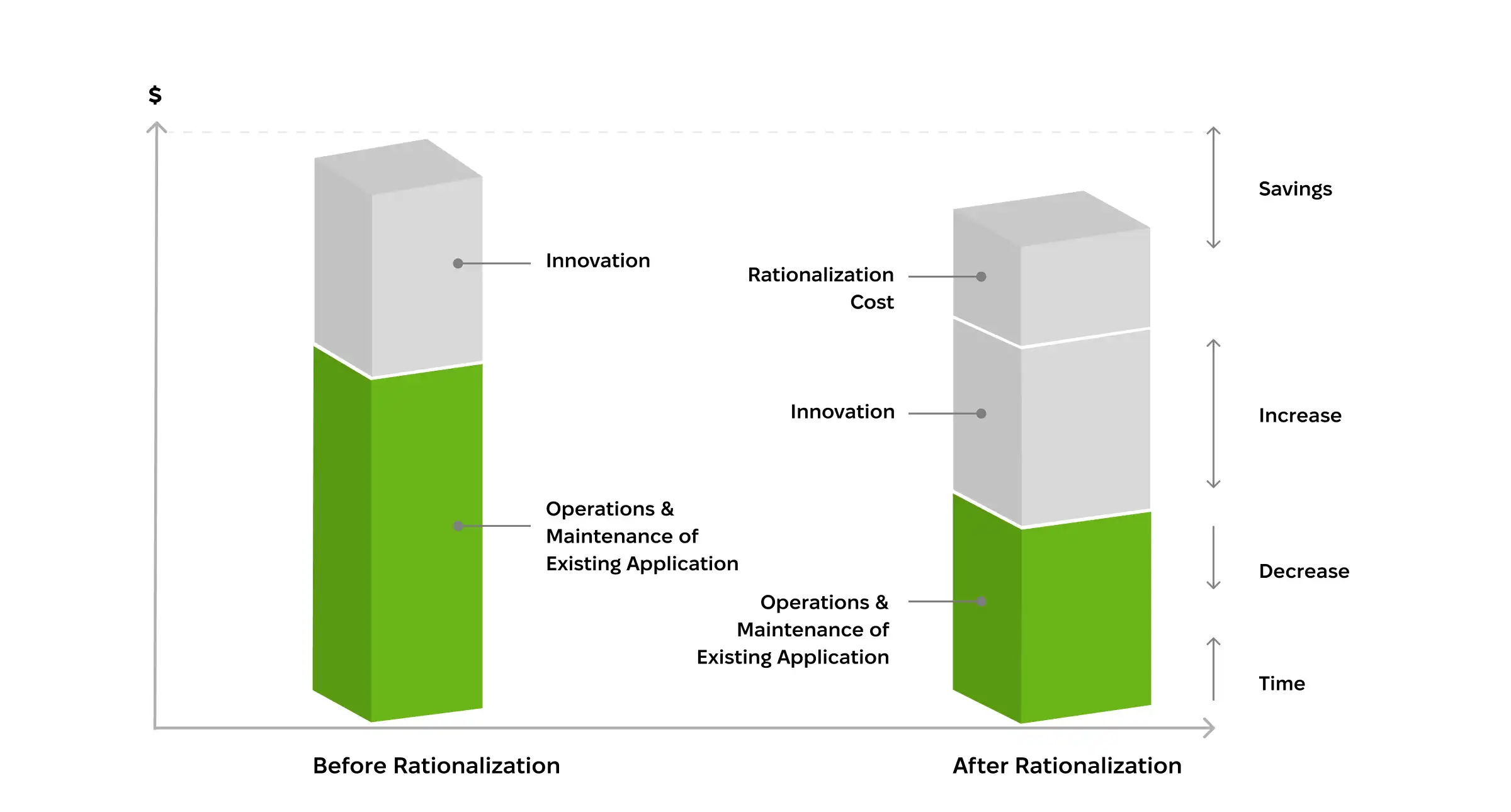
Here are the best practices we typically apply:
If you find application rationalization overwhelming, you may consider partnering with dedicated specialists. But how do you make sure you’re working with the right experts? And which criteria to pay attention to? While we’ve shared some helpful tips on managing outsourced team, here’s our checklist for picking a suitable partner for system rationalization:
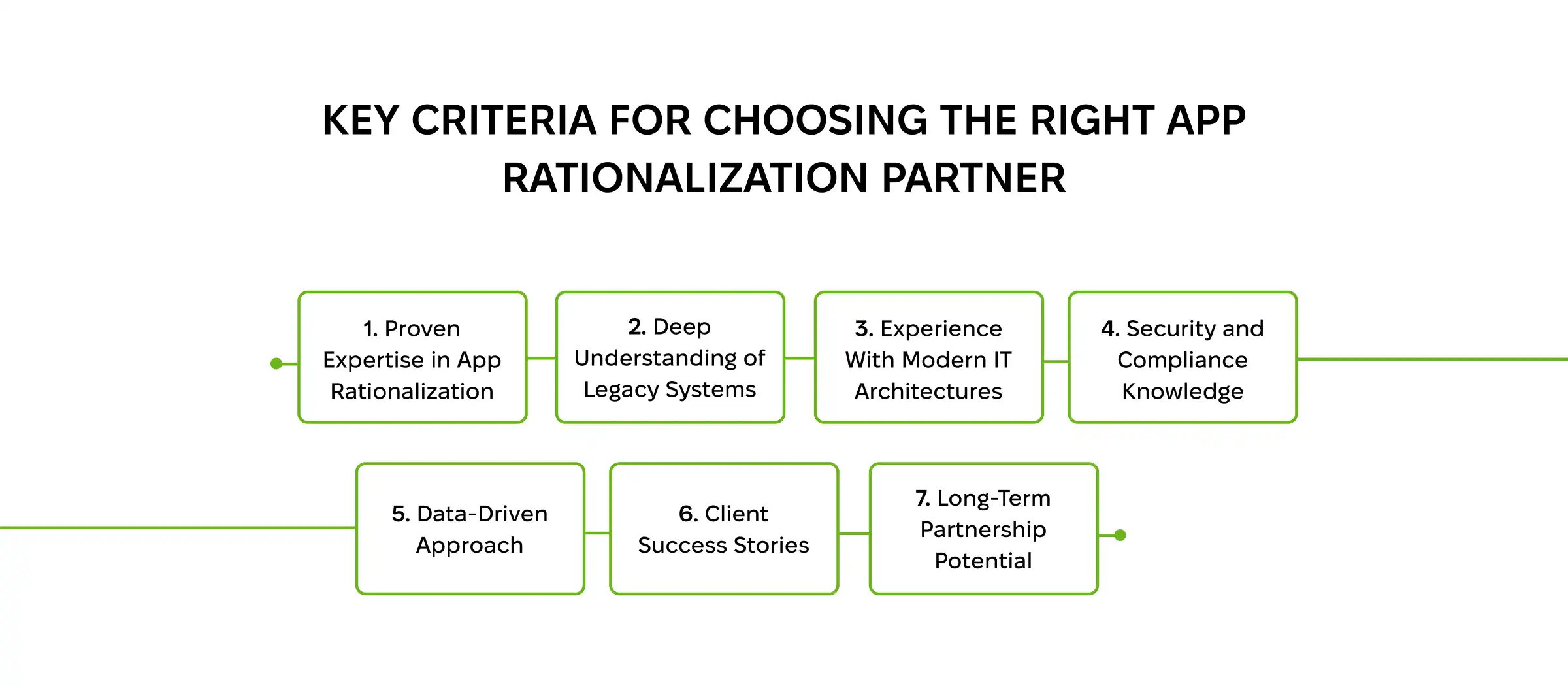
All in all, a decent partner for IT portfolio optimization must be proficient in both modern and legacy systems — key knowledge to determine your best path forward. Where to look for such specialists? Think about Eastern Europe. In our recent guide, we explain why to hire developers from Ukraine.
Check out our work!
As mentioned several times, app rationalization is more than just cutting costs. It’s a way to make your enterprise more agile, efficient, and, ultimately, ready for the future.
If you’re still managing a bloated software stack, now’s the time to take action. Evaluate your current apps — which ones add value, and which ones are just draining resources — and streamline your IT portfolio.
Get an expert assessment from our team!
To avoid business process disruption, adopt a phased approach. Start with less critical apps, use application rationalization tools for discovery, and plan everything carefully.
Organizations should handle IT portfolio streamlining — or app rationalization — periodically. This means at least once every year or after any major change in technologies or organizational needs.
It depends, but often, yes. Even small businesses need efficient IT ecosystems. If outdated or redundant apps do not offer the required capabilities, rationalization and modernization are a must.
The price of modernization can vary widely. It depends on the complexity of your apps and desired upgrades, such as AI and ML. You can learn more about these technologies in our Integrate GPT into App Guide. Contact us for a detailed quote and roadmap if you need an accurate cost.
Of course. Customer-facing apps, security systems, data analytics platforms, and any area where outdated features impact your efforts. Also, consider areas critical to the overall success of your business.